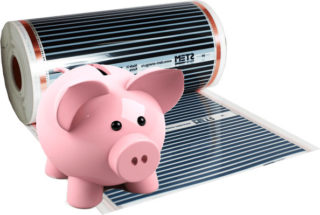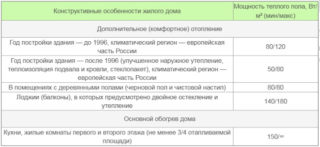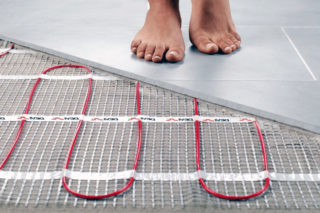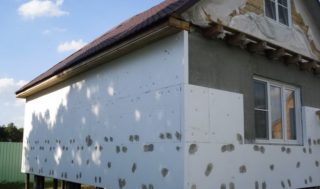An important indicator taken into account when installing a warm floor is the amount of energy consumed. Thanks to the installation of such a system, energy costs for heating a room are reduced by about 15%. Warm air rises, so when using a radiator for heating, you need more energy to warm it below. With a warm floor, such a problem does not arise. To accurately determine the amount of energy consumed, first calculate the total power of the warm floor, and then the specific power of the heating equipment, which is determined in watts per square meter.
Necessary data for calculation
Significantly affect the calculation of the features of the room. If it is poorly insulated, unheated rooms or external walls with a window of two or more adjoin it, the energy consumption for heating the room will be higher, so the power of the warm floor should be greater. However, in simplified calculations, only the area of the room is taken into account, although in this case it is more correct to take into account not the area, but the volume. The result of a simple calculation will be close to real if the height of the ceilings in the room is approximately 2.7 m. If the ceilings are high, the power of the system, ceteris paribus, should be higher, since more energy is required to heat more air. Then it is necessary to include a correction factor in the calculations.
The type of warm floor also has some influence on the calculation, since the power of different types of heaters per square meter is different. The heat transfer to a large extent depends on the thermal conductivity of the floor: tiles, self-leveling floors are optimally suited for installation. Wood does not conduct heat well; it is not recommended to install such a system under wooden floors.
If the floor will be used as the main means of heating, its power should be 180-200 W / m2, if as an additional - 100-160 W / m2, provided that the system is installed over the entire area.
The area on which the furniture is installed or dense carpets are not taken into account in the calculations, since the manufacturer does not recommend laying the warm floor in these areas.
An important feature: always take into account the possibilities of electrical wiring. In older homes, wiring may not withstand the high power of the system.
Calculation of capacities per square meter
When heating any room in any building, there will be greater or lesser heat loss. To calculate them accurately, you need to take into account the geographical position, number of storeys of the room, the area of windows, material and wall thickness and other parameters. It is convenient to use special calculators for calculations or to resort to simplified calculations.
Suppose heat losses are calculated in one way or another, then to calculate the total recommended power, you should resort to the formula:
Pud. = Pust. / Suwhere
- Su. - the area on which the warm floor will be laid;
- Rust - the necessary total system power;
- Pood. - specific power of the warm floor, i.e. power per 1 m2.
It is necessary to calculate Rust according to the formula:
Pust = 1.3 × Pp, Where
- P - heat loss;
- 1,3 - correction factor, taking into account the fact that the power of the heating elements should be approximately 30% higher than heat loss.
Suppose that in a room with an area of 17 m2 the heat loss was 2000 W, then Rust = 1.3×2000 or 2600W.
Let a warm floor system be laid on 70% of the area, we expect 17 * 0.7 = 11.9 m2. Such is the area of the warm floor. So, substituting the values in the first formula, we get 2600 / 11.9 = 218 W / m2. This is the value of the specific power of the system, which is used as the main source of heat.
Please note that the requirements for specific power will vary depending on the purpose of the room. These data are indicated in the table reflecting the requirements for the specific power of the underfloor heating used as an additional source of heating (heat losses are compensated by radiator heating).
| Purpose of the room | Average power, W / m2 |
| Glazed balcony (loggia) | 180 |
| Bedroom | 120-130 |
| Kitchen | 120-130 |
| Living room | 120-130 |
| Children | 140 |
| Bathroom | 140-150 |
| Ground floor rooms | 140-160 |
If linoleum or laminate is used as the flooring, the specific power of the warm floor should not exceed 100-130 W / m2.
The required power for space heating is calculated by the formula Pust = Pud × Sуmeans 120×11.9 = 1428 watts.
It is recommended to install a warm floor, the power of which is higher than the recommended one by 20-30%. The power reserve is necessary for the normal operation of the equipment, since it should not constantly work at the limit.
Calculation depending on the types of underfloor heating
Accessories for underfloor heating devices vary in type, power, length and width. To choose the best option, taking into account the calculated values, you need to understand the features of each variety.
Power cable
For device systems use a single-core or two-core resistive heating cable. It costs less than other varieties of underfloor heating. The cable is laid in turns or with a snake, fixed with special clamps, poured on top with a screed. The resistive cable must not be shortened. Because of this, the resistance changes, the current increases and the entire system setting gets lost.
The thicker the screed, the greater the heat loss. The optimum thickness of concrete is about 5 cm, so bulk floors are mainly used. Only in some cases, in order to save money, when the night electricity tariff is lower, it is advisable to organize a thick 10-15-cm heat-accumulating screed. At night, it warms up and during the day will give heat to the room.
In those areas where furniture is placed or the floor is covered with a dense fabric, it is not advisable to lay the heating cable. This leads to an excessive consumption of energy, overheating of the cable and damage to furniture, because the resistive conductor heats up evenly. If for some reason it is necessary to lay it in areas with poor heat transfer, you need to use the self-regulating option. Its resistance depends on the temperature at the site. However, due to the high cost of this variety, underfloor heating cables from a self-regulating cable practically do not. Thus, the power of a warm floor should be calculated taking into account only areas free of furniture and carpets.
The heating cable has a linear power of 10 to 60 W per m2 and an average of 4-5 turns per square meter. In total, the specific power of the cable floor comes out 120-150 W / m2. If linear power is not specified, you can calculate it by dividing the total cable power by its length.
When calculating the specific power of a warm floor from a heating cable, an important parameter should be taken into account - the installation step. It is calculated by the formula:
h = Su × 100 / Lcabwhere
- h - laying step;
- Su - heated area;
- Lcab - length of cable.
The optimal distance between the loops is 7.5-10 cm. With the most dense installation, there is a possibility of self-heating of electric cables - it will not have time to give off heat. The service life of the underfloor heating in this case is reduced.
Thermomat
Using a cable in the mats is much more convenient than a regular heating cable. Mats do not need to be fixed, just lay them on the floor, make a self-leveling thin screed, lay a laminate, parquet on top, lay the tiles. Cable underfloor heating in mats will feel great under a layer of tile glue.
For the manufacture of thermomats, usually a two-wire resistive cable is used, therefore it is impossible to cut the mat along the conductors. You can cut only the polymer mesh on which it is attached. The specific power of the thermomat is 100-150 W / m2, much less than 200 W / m2. If the system will be used as an additional one, it is enough to take the values of specific power from the table above, in accordance with the type of room, and choose a thermomat of suitable power.
Infrared film
The infrared film is made on the basis of carbon. It is very thin, so you can lay it under almost any floor covering. Features of an infrared film in principle of action: infrared radiation heats not air, but objects. Also, the film floor is characterized by high efficiency - it reaches 95%. It is necessary to lay such a floor in a dry way, making sure that a gap of 20 cm is maintained from the edges of the film and walls (furniture). You can cut the film not anywhere, but usually only every 25 cm.
The specific power of such a system varies from 130 to 230 W / m2. To accurately calculate the required value, you will need a floor plan on a scale, made on graph paper, with an accurate layout of the film. Using it, the styling area is calculated. For example, it is equal, taking into account the necessary indents - 10 m2 (total area - 17 m2). It is necessary to calculate the percentage of the total area of the room: Su × 100% / Total. It turns out 10 × 100/17 = 58.8%. If the area is less than 60%, then choose an IR film with a specific power of 220 W / m2, if more than 60%, then from 160 to 220 W / m2. If necessary, calculate Rust by the formula Pust = Pud × Sу or for a specific example, 220 × 10 = 2200 watts.
Power Reduction Options
The financial cost of heating a room using a warm floor system can be palpable. You can reduce power consumption and save money in several ways:
- The house or apartment should be properly insulated. If the heat loss is negligible, it will be possible to save 35-40% of energy, due to this financial costs will be reduced in the same way.
- About 30% of the electricity can be saved thanks to the installation of a thermostat in the coldest point of the room. The system will automatically turn on and off when the set threshold is exceeded or the temperature drops below the set value.
- In some regions, different tariffs have been introduced for day and night electricity consumption. In this case, it is recommended to install a two-tariff or three-tariff meter, install a cable floor, fill in a thick heat-accumulating concrete screed and turn on the warm floor at night.
- Warm floors need to be laid only in areas free of furniture. Installation under carpets and furniture harms the system itself and leads to an excessive consumption of thermal energy.
By lowering the room temperature by one degree, you can save about 5% of the total cost.
The warm floor system allows you to create the most comfortable microclimate in the room. But before you purchase a cable, mats or IR film, you need to calculate the required power of the warm floor per square meter. The material features are such that it is impossible to simply take and cut off the excess cable or film.









